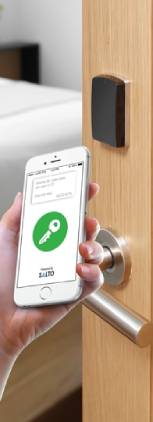Access Control Solutions Guide In A Nut Shell
Electronic Access Control as a Management System
New technologies with internet-based systems allow companies to manage and document staff activity. An employee enters the secure space using a smartphone or ID badge to verify credentials. At the point of entry, the access control system logs the event. Managers can then retrieve reports and make decisions based on usage. Utilizing access control under the umbrella of operations management can identify areas for improvement and help the company use office space more efficiently. For instance, a business can track how often employees use the conference room or break room, or access records stored in a file cabinet.
Securing Confidential and Proprietary Access in an Open Office
The conversion from private offices to open spaces also has created unique challenges to securing confidential and proprietary information within the office environment. When managers and executives share the same space as entry-level employees, there can be a gap in individuals’ necessary access credentials, requiring businesses to rethink physical security measures to protect sensitive data.
Innovative companies have the means of restricting and granting access down to a single drawer or file cabinet. For example, allows managers to assign access for each lock in a building. Managers might have access to every area and assign employees individualized access based on their roles with the company, making it possible to have multilayered security protocols.
Securing confidential information on a micro level can secure an area while embracing the open office concept so popular in Silicon Valley.
Electronic Access Control Features
Customers seeking to convert to an access control system look for features based on what they need the system to do. They must choose between:
1) A fail-safe or fail-secure device
2) Electromagnetic or electromechanical locks
3) A stand-alone device or integrated system
Let’s look at each of these decisions.
Fail-Safe vs. Fail-Secure
A fail-safe lock requires an electrical current to remain locked. An interruption in power will leave the area unsecured. Whether the disruption comes from a storm or sabotage, the vulnerability of an unlocked area is the chief weakness of a fail-safe lock.
On the other hand, a fail-secure lock stays locked. It requires electrical power to be released, maintaining security until a panic bar is activated, a system overrides, or power is restored. Thus, a fail-secure locking device provides the highest level of security.
Fire codes, compliance regulations, and the importance of the items secured will determine if the application requires a fail-safe or fail-secure locking device.
Electromagnetic vs. Electromechanical
Choosing electromagnetic locks, commonly referred to as maglocks, provides a fail-safe solution. Businesses often select these devices to control access to secure areas that do not contain confidential information or resources. For example, an office building might use electromagnetic locks for conference rooms or break rooms, preventing guests from entering employee areas. Apartment complexes and hotels often use maglocks to secure pools, gyms, and other amenities only offered to residents or registered guests.
However, companies choose electromechanical locks, also called electronic strike locks or e-locks, to secure areas containing confidential or proprietary information or assets. Offices with computers, cash, or customer or other confidential data require higher levels of security. For example, an office building might have stricter access to certain floors, executive offices, and desks and file cabinets storing proprietary data.
E-locks can operate in fail-secure or fail-safe mode, making them the primary choice to secure company assets or customer data in a physical location. Both maglocks and e-locks can accommodate a range of entry credentialing devices, including keypads, fobs, swipe cards, smartphones, or biometrics.
Standalone vs. Integrated System
A standalone device operates independently from other security or corporate systems, whereas an integrated access control system can communicate with other networks within the company or office. It is easier and cheaper to install a stand-alone device because it does not require compatibility with existing systems. However, that incompatibility also limits its use, and can require a separate set of credentials for users and a separate process to grant or cancel access.
An integrated system allows a single process to operate multiple areas, and it creates a comprehensive network and a seamless user experience. The system might coordinate with other security solutions, such as video cameras, alarms, fire detectors, or lighting, working in tandem to provide an effective and efficient security system. Other common integration measures coordinate access credentials to employee on-boarding and termination processes. The downside is that an integrated device must have software and hardware compatible with the existing system or network.
Benefits of Electronic Access Control
Advanced electronic access control systems, solutions, offer these important advantages:
- Improved physical security: Choosing an electronic access system provides users with a higher level of security than traditional locks and keys, without the need for physical keys. Managers can grant, suspend or cancel credentials within seconds.
- Reduced risk of internal theft: Access control systems that include monitoring enable managers and owners to track who enters which secure space, when. Tracking features can identify a problem employee and provide evidence in the event of prosecution.
- Easier compliance with industry regulations: Industries that regularly collect and store confidential customer data must provide additional security measures to ensure the safety and security of the information or assets they maintain. Federal and state regulators typically require written policies and procedures addressing security protocols along with reports, ensuring the company maintains industry standards.
- Streamlined business operations: Innovative technologies allow companies to use electronic access control to improve operational efficiency. Monitoring employee behavior gives a company additional tools to better manage employee access to secure areas.
Selecting an Electronic Access Control System
Smartphone capabilities and wireless communications are rapidly changing the landscape of access control. Beyond basic security, companies also care about the quality of the hardware, the ability to update and upgrade software, and the encryption of wireless communications between the lock and the receiver. Other factors include the ease of changing user credentials, integration capabilities, allowing multi-factor authentication, and providing a seamless user experience.
When evaluating an access control system, the top factors to weigh include:
Application and security needs: Understanding the security requirements of an area will narrow the choice of access systems. Secured access often involves entrances, elevators, storage rooms, file cabinets, desks, and drawers containing sensitive corporate or customer information or assets.
Compliance needs: Is the business required to adhere to industry regulations governing security? If so, does the company have to submit reports or establish policies and procedures to ensure employees implement security measures?
Compatibility requirements: Will the device operate independently, or does it need to communicate with other security and business systems for optimal efficiency?
Installation needs: Does the business require simple installation? Ease or complexity of installation differs based on whether the company chooses a stand-alone or integrated access control system. Few of our products provide a reliable cabinet locking solution with a plug-and-play system that is easy to install and simple to operate, reducing the time spent on servicing.
Projected business growth: Select a system that will grow with the company and can be upgraded as technological advancements reach the market.
Level of customer support: Most electronic devices have a range of valuable but underused features. Access to professional support through the sales process, installation and beyond can increase product satisfaction.
New technologies give businesses more options than ever to secure physical spaces. Modern electronic access control systems can monitor and track employee activity, allowing operations managers to use the open office environment and stem internal theft. The ability to assign credentials for each secure area down to the drawer or file cabinet can mitigate the challenges of working with an open floor plan while maintaining the high levels of security required.











